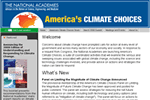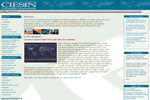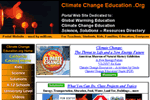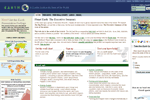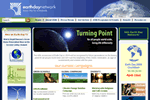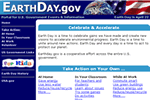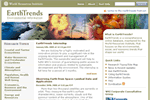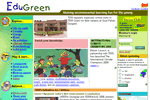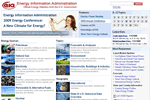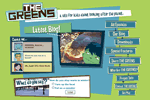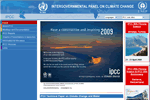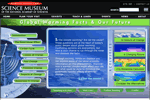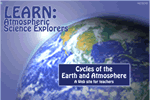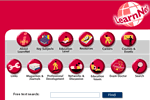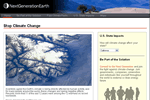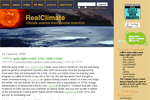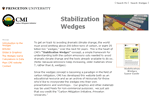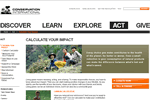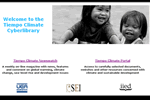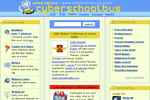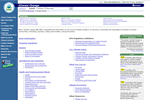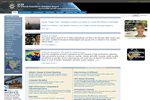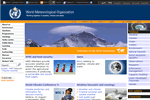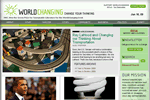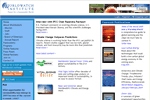Online Resources
This is a collection of online resources (websites, software, etc.). A separate collection of Book and Video Resources is also available.
Key: E=Elementary (K–5), I=Intermediate (6–8), HS=High School (9–12), C=College, G=General Public
- America’s Climate Choices (HS, C, G)
- Concerns about climate change have prompted calls for action at every level of
government and across many sectors of our economy and society. In response to a
request from Congress, the National Academies are launching America’s Climate
Choices, a suite of coordinated activities that will examine the serious and sweeping
issues associated with global climate change, including the science and technology
challenges involved, and provide advice on actions and strategies the nation can take
to respond.
Provided by: The National Academies. - CarbonCounter.org — Fight Climate Change (I, HS, C, G)
- Every time we drive, fly, run appliances at home and keep our houses lighted, warm
and cool, we emit carbon dioxide, trapping heat in the atmosphere. Be part of the
solution and offset your emissions! Your tax deductible donation contributes to
the development of new technologies and alternative energy that reduce carbon dioxide
emissions. Take the first step, and calculate your carbon footprint.
Provided by: The Climate Trust. - Center for International Earth Science Information Network (HS, C, G)
- CIESIN’s mission is to provide access to and enhance the use of information
worldwide, advancing understanding of human interactions in the environment and
serving the needs of science and public and private decision making. CIESIN
continues to focus on applying state-of-the-art information technology to pressing
interdisciplinary data, information, and research problems related to human
interactions in the environment.
Provided by: Earth Institute, Columbia University. - ClimateChangeEducation.Org (E, I, HS, C, G)
- Created by volunteers: docents, scientists, teachers, students, artists…
Based at California science museums, K–12 schools and University of California
campuses. Hands-on science demonstrations is our specialty — our principal
contribution to the body of original educational material. An example is the Global
Warming Discovery Demo — a favorite at science centers and museums, in K–12
schools, UC classes, and at large community events. Much of our work is bridge-building,
encouraging partnerships in education. The California Catalog, an online resource center,
is a web version of this.
- Earth: A Graphic Look at the State of the World (I, HS, C, G)
- A few years ago a group of educators from BC, Canada set out to try to get an
objective look at the state of the world. They wanted The Big Picture, not just
this or that issue, but the most essential points of every important issue. The
Executive Summary of the state of the planet. This web site is the result of that
search. The site (and the accompanying wall chart) are here to show you —
in as clear, objective, and accessible a format as possible — the condition
of the world — both its natural and human elements.
Provided by: The Global Education Project. - Earth Day Network (E, I, HS, C, G)
- The EDN grew out of the original Earth Day in 1970. Earth Day Network is a driving
force steering environmental awareness around the world. Through EDN, activists connect,
interact, and have an impact on their communities, and create positive change in local,
national, and global policies. EDN’s international network reaches over 17,000
organizations in 174 countries. Our domestic programs engage 5,000 groups and over 25,000
educators coordinating millions of community development and environmental protection
activities throughout the year. Earth Day is the only event celebrated simultaneously
around the globe by people of all backgrounds, faiths and nationalities. More than a
billion people participate in Earth Day each year.
- Earth Day — U.S. Government Portal (E, I, HS, C, G)
- Earth Day is a time to celebrate gains we have made and create new visions to accelerate environmental progress. Earth Day is a time to unite around new actions. Earth Day and every day is a time to act to protect our planet. Earthday.gov is a cooperative effort across the entire U.S. government.
- EarthTrends — Environmental Information (I, HS, C, G)
- EarthTrends is an online collection of information regarding the environmental, social,
and economic trends that shape our world. Much of the environmental information on the
internet is fragmented, buried, or only available at a price. EarthTrends gathers data from
the world’s leading statistical agencies, along with WRI-generated maps and analyses,
into a single database for rapid searching and retrieving. To facilitate the comparison of
data from different sources, EarthTrends supplements its content with detailed metadata that
reports on research methodologies and evaluates the information’s reliability. All of
these resources are made available to the public at no charge.
Provided by: World Resources Institute. - EduGreen: Making Environmental Learning Fun for the Young (E, I)
- Explore the environment around you through the Life on earth, Forestry, Energy, Water, Air
pollution, and Climate change. Enrich your knowledge through quizes, maps, a time line,
environmental laws, multimedia resources, and an environmental calendar.
Provided by: The Energy & Resources Institute, New Delhi, India. - Energy Information Administration — Official Energy Statistics from the U.S. Government (E, I, HS, C, G)
- The Energy Information Administration (EIA), created by Congress in 1977, is a statistical
agency of the U.S. Department of Energy. Our mission is to provide policy-neutral data,
forecasts, and analyses to promote sound policy making, efficient markets, and public
understanding regarding energy and its interaction with the economy and the environment.
Includes an “Energy Kid’s Page.”
Provided by: U.S. Department of Energy. - Global Footprint Network (Also in German) (I, HS, C, G)
- Humans are the most successful species on the planet. But we are using more resources
than the Earth can provide. An essential step in creating a one-planet future is measuring
human impact on the Earth so we can make more informed choices. That is why our work aims
to accelerate the use of the Ecological Footprint — a resource accounting tool that
measures how much nature we have, how much we use, and who uses what.
Provided by: Global Footprint Network. - The Greens — A Site for Kids About Looking After the Planet (E, I)
- The GREENS is a site for kids about sustainability and green living. With The GREENS,
we get kids thinking about the world and their place in it. The GREENS project is upbeat
and optimistic. We encourage kids to make informed choices and meaningful changes.
Through the animated episodic adventures, a blog, kids’ mail, and regular updates,
we explore green living, sustainability, ecology, environmental care, and social equity.
We nudge kids to research, to challenge, to discover, and to take action whereever and
whenever they can. Green Business named us as one of the “Ten Best Environmental
Sites on the Web.”
Provided by: WGBH. - Intergovernmental Panel on Climate Change (Some content in 6 languages) (HS, C, G)
- The IPCC was established to provide the decision-makers and others interested in
climate change with an objective source of information about climate change. The
IPCC does not conduct any research nor does it monitor climate related data or
parameters. Its role is to assess on a comprehensive, objective, open and transparent
basis the latest scientific, technical and socio-economic literature produced
worldwide relevant to the understanding of the risk of human-induced climate change,
its observed and projected impacts and options for adaptation and mitigation.
- Koshland Science Museum — Global Warming Facts & Our Future (I, HS, C, G)
- Is the climate warming? Are we the cause? These questions are at the heart of
today’s public debate about global warming. Conflicting opinions are everywhere,
but now is your chance to cut through the noise and discover the facts. This exhibition
explores issues related to global warming, including possible implications of this
phenomenon for the quality of life worldwide.
Provided by: Marian Koshland Science Museum of the National Academy of Sciences. - LEARN: Atmospheric Science Explorers — Cycles of the Earth and Atmosphere: A Web Site for Teachers (I)
- The fundamental goal of both LEARN is to increase middle school science teacher knowledge
of and interest in the atmospheric sciences. The three modules include background information,
hands-on activities using simple materials, and authentic assessment tools. The modules were
not designed to replace existing curricula or textbooks. Rather, they were intended to enhance
earth and physical science programs by incorporating atmospheric science concepts. These modules
were created by teachers for teachers.
Provided by: University Corporation for Atmospheric Research. - LearnNet (E, I, HS, C)
- LearnNet is for the use of teachers and students of chemistry at all levels. The network
provides access to products and information relevant to the study of chemistry. Many resources
are available free only on LearnNet. The entries are classified by experts in chemistry teaching
to ensure that the best interests of the users are attended to at all times.
Provided by: Royal Society of Chemistry. - Next Generation Earth — Stop Climate Change (I, HS, C, G)
- Commit to the Next Generation and join the fight against climate change. Join governments,
companies, universities and individuals like yourself throughout the world to endorse a clean
energy future.
Provided by: Earth Institute, Columbia University.- Interactive Map Tool/U.S. Emissions Data (I, HS, C, G)
- http://www.nextgenerationearth.org/maps
- RealClimate — Climate Science from Climate Scientists (HS, C, G)
- RealClimate is a commentary site on climate science by working climate scientists
for the interested public and journalists. We aim to provide a quick response to
developing stories and provide the context sometimes missing in mainstream commentary.
The discussion here is restricted to scientific topics and will not get involved in
any political or economic implications of the science. All posts are signed by the
author(s), except ‘group’ posts which are collective efforts from the whole
team. This is a moderated forum.
- Stabilization Wedges: A Concept and a Game (HS, C)
- To get on track to avoiding dramatic climate change, the world must avoid emitting
about 200 billion tons of carbon, or eight 25 billion ton “wedges,” over
the next 50 years. This is the heart of CMI’s “Stabilization Wedges”
concept, a simple framework for understanding both the carbon emissions cuts needed to
avoid dramatic climate change and the tools already available to do so. The Stabilization
Wedges Game is a team-based exercise that teaches players about the scale of the
greenhouse gas problem, plus technologies that already exist to dramatically reduce our
carbon emissions and get us off the path toward dramatic and damaging climate change.
Provided by: Carbon Mitigation Initiative, Princeton University. - Take Action — Calculate Your Impact (I, HS, C, G)
- Living green means knowing, acting, and sharing. To make responsible choices, you have
to know about your impact. Then you can start making positive changes in your lifestyle.
As you start to see the benefits of your decisions, share your stories with your friends
and family. Living green can be an individual choice, but it can also be a community goal.
Excellent site with many multimedia features.
Provided by: Conservation International. - Tiempo Climate Cyberlibrary (I, HS, C, G)
- Includes Tiempo Climate Portal that provides access to carefully selected documents,
websites and other resources concerned with climate and sustainable development. This
site includes Tiempo Climate Newswatch, a weekly on-line magazine with news, features
and comment on global warming, climate change, sea-level rise and development issues.
Check out the Theme Sites which has annotated list of links on a variety of
environmental, weather, and climate-related topics.
Provided by: Climatic Research Unit, School of Environmental Sciences, University of East Anglia. - UN Cyberschoolbus (Some web pages are available in 6 languages) (E, I, HS, G)
- The UN Cyberschoolbus captures the growing potential of the Internet as an
educational tool and provides an effective medium with which to disseminate
information and resources about international affairs, as well as bring together
diverse communities of students and educators from around the world. Within the
Cyberschoolbus site there are a number of activities and projects that teach
students about global issues in an interactive, engaging and fun way. Their
interactive database, InfoNation, contains accurate, official, and up-to-date
information and statistics on the countries of the world.
Provided by: United Nations. - U.S. Environmental Protection Agency — Climate Change (Some EPA Content in 7 languages) (I, HS, C, G)
- EPA’s Climate Change Site offers comprehensive information on the issue of
climate change in a way that is accessible and meaningful to all parts of society —
communities, individuals, business, states and localities, and governments.
- Climate Change for Kids (E, I)
- URL: http://www.epa.gov/climatechange/kids/index.html
- The University Corporation for Atmospheric Research (I, HS, C, G)
- The University Corporation for Atmospheric Research (UCAR) promotes partnership
in a collaborative community dedicated to understanding the atmosphere-the air
around us-and the interconnected processes that make up the Earth system, from the
ocean floor to the Sun’s core. UCAR serves as a hub for research, education,
and public outreach for the atmospheric and Earth system science community.
- Kids’ Crossing (E, I)
- URL: http://www.eo.ucar.edu/kids/index.html
- World Meteorological Organization (I, HS, C, G)
- The WMO is a specialized agency of the United Nations. It is the UN system’s authoritative voice on the state and behaviour of the Earth’s atmosphere, its interaction with the oceans, the climate it produces and the resulting distribution of water resources.
- Worldchanging — Change Your World (I, HS, C, G)
- Worldchanging was founded on the idea that real solutions already exist for
building the future we want. It’s just a matter of grabbing hold and getting
moving. Worldchanging is a media organization that comprises a global network of
independent journalists, designers and thinkers covering the world’s most
intelligent solutions to today’s problems. They inspire readers around the
world with stories of the most important and innovative new tools, models and ideas
for building a bright green future.
Provided by: Worldchanging, Seattle. - WorldWatch Institute (I, HS, C, G)
- The Worldwatch Institute is an independent research organization recognized by opinion leaders around the world for its accessible, fact-based analysis of critical global issues. Its mission is to generate and promote insights and ideas that empower decision makers to build an ecologically sustainable society that meets human needs.
- Zerofootprint: Footprint Kids Calculator (E, I)
- The Zerofootprint Kid’s Calculator measures the direct impact of a child’s
lifestyle on the planet. Their measurements are made in terms kids understand: carbon,
land, water and trees.
Provided by: ZeroFootprint.net.


